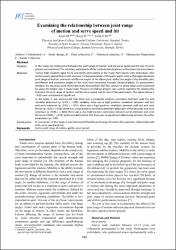| dc.contributor.author | Soyal, Mehmet | |
| dc.contributor.author | Kaya, Mustafa | |
| dc.contributor.author | Çelik, Nuri Muhammet | |
| dc.date.accessioned | 2023-11-30T15:58:18Z | |
| dc.date.available | 2023-11-30T15:58:18Z | |
| dc.date.issued | 2019 | en_US |
| dc.identifier.issn | 2075-5279 | |
| dc.identifier.issn | 2308-7250 | |
| dc.identifier.uri | https://hdl.handle.net/11363/6599 | |
| dc.description.abstract | Purpose: In this study, the relationship between the joint range of motion, and the serve speed and hit rate of tennis
players was examined. The voluntary participants of this study are tennis players in the university tennis team.
Material: Twelve male students aged 18-25 voluntarily participated in the study. Participants were individuals, who
professionally played tennis with a license. Certain parameters of the participants such as the upper extremity
joint range of motion, extension and flexion angles of the elbow joint, abduction angle of the shoulder joint,
and flexion and extension angles of the wrist were measured through standard plastic 12 goniometers.
Similarly, the hit values were examined via the Revised Dyer Wall Test and serve speed values were examined
by using the Stalker solo 2 brand radar. Pearson correlation analysis was used to examine the relationship
between the joint range of motion and the serve speed and hit rate of the participants. The values below p
<0.05 were considered as significant.
Results: In the study, it was determined that there was a moderate positive correlation between wall test and
shoulder abduction (p <0.05, r =.599); similarly, there was a high positive correlation between wall test
and wrist extension (p <0.05, r = 671); there was a high positive correlation between wall test and wrist
flexion (p <0.05, r = 638); there was a high positive correlation between abduction of the shoulder and wrist
extension (p <0.05, r =, 603); there was a very high positive correlation between wrist extension and wrist
flexion (p <0.001, r = 819), and it was determined that there was no significant relationship between the other
parameters (p> 0.05).
Conclusions: In conclusion, in this study, it was determined that the joint range of motion has a positive relationship with
both serve speed and hits. | en_US |
| dc.language.iso | eng | en_US |
| dc.publisher | IERMAKOV S S, BOX 11135, KHARKOV-68 61068, UKRAINE | en_US |
| dc.relation.isversionof | 10.15561/20755279.2019.0305 | en_US |
| dc.rights | info:eu-repo/semantics/openAccess | en_US |
| dc.subject | tennis | en_US |
| dc.subject | joint range of motion | en_US |
| dc.subject | agility | en_US |
| dc.subject | serve speed | en_US |
| dc.title | Examining the relationship between joint range of motion and serve speed and hit | en_US |
| dc.type | article | en_US |
| dc.relation.ispartof | Physical Education of Students | en_US |
| dc.department | Beden Eğitimi ve Spor Yüksekokulu | en_US |
| dc.authorid | https://orcid.org/0000-0001-6528-0275 | en_US |
| dc.authorid | https://orcid.org/0000-0002-2438-2678 | en_US |
| dc.authorid | https://orcid.org/0000-0001-6403-6262 | en_US |
| dc.identifier.volume | 23 | en_US |
| dc.identifier.issue | 3 | en_US |
| dc.identifier.startpage | 142 | en_US |
| dc.identifier.endpage | 146 | en_US |
| dc.relation.publicationcategory | Makale - Uluslararası Hakemli Dergi - Kurum Öğretim Elemanı | en_US |
| dc.contributor.institutionauthor | Soyal, Mehmet | |

















